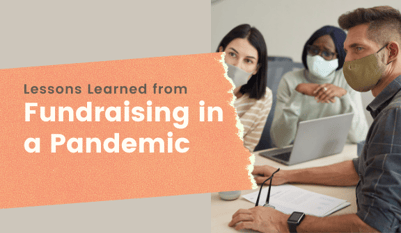![]() As we begin to feel the warmer breezes of Spring and the sense of renewal it brings with it, it seems a great time to reflect on what we learned—and not just say “Good riddance!” to a most unusual year. We may just find that there are some lessons we learned as we pivoted during the pandemic which we can carry forward to help boost relationships, efficiency, and even fundraising results.
As we begin to feel the warmer breezes of Spring and the sense of renewal it brings with it, it seems a great time to reflect on what we learned—and not just say “Good riddance!” to a most unusual year. We may just find that there are some lessons we learned as we pivoted during the pandemic which we can carry forward to help boost relationships, efficiency, and even fundraising results.
LESSONS LEARNED
Donors continued to be generous
Even during the early months of the COVID-19 pandemic, donors continued to give—and give generously. In fact, charitable giving increased by 7.6% during the first nine months of 2020, when compared with 2019, according to the Fundraising Effectiveness Project. Some donors were undoubtedly motivated to help those who were directly affected by the pandemic, but that was not the sole driver of the uptick in giving. Although 22% of donors were motivated by their desire to help institutions weather a COVID-19 economic downturn, the top five donor priorities remained the same as before the crisis and in the same rank order.
Takeaway: Don’t stop fundraising! Campaigns and generosity are moving forward. We know that organizations fare much better historically when they stay in touch with their donors for the long haul. Donors want to be informed, even though it might not be the right time for them to make a gift right then.
Volunteering decreased
It will come as no surprise, but volunteer activity dramatically decreased due to COVID-19. Social distancing restrictions and other necessary precautions made in-person volunteering impractical to impossible and this trend may continue for some time. For many, volunteering is their primary way to connect with your organization and stay up to date on what is going on at any given time.
Takeaway: Engage volunteers in different ways to ensure they still feel connected to our organization. That could take the form of newsletters, email updates, phone calls, and videos. Stay in front of your core group of volunteers – who are also often donors! And when they do come back, make sure they know they have been missed!
Virtual engagement worked well
The pandemic forced many organizations to increase their use of technology in creative ways, often by organizations with little experience. We saw a quick pivot to virtual visits as face-to-face meetings came to a screeching halt. Donors seemed to adapt to this mode of communicating and many staff members saw a desire from donors to simply connect. While communicating virtually was not the same as an in-person visit, donors appreciated the fact that organizations were checking in with them and keeping in touch during a difficult time for everyone concerned. It was a great way to share news about your organization and to ask for thoughts and advice from your donors.
Fundraising events and galas also had to cancel or shift gears quickly due to the pandemic. But, nonprofits that pivoted to virtual events were more likely to be raising at or above their budgets according to a report from OneCause, Fundraising Through a Pandemic. About 60% of those organizations which held a virtual or hybrid event—either met their goal or exceeded it by up to 10%.
Takeaway: Virtual has an upside. Maybe those virtual meetings and events should not be a last resort. For some organizations, an unplanned pivot may become a best practice for the future. As you were forced to make adjustments, it showed donors your flexibility and ability to innovate. You can now implement what worked well and continue to test new ideas, knowing your donors are open to that nimbleness and creativity.
LOOKING AHEAD WITH OPTIMISM
Being nimble and creative is here to stay.
All of the endless Zoom meetings and virtual events of the past year may have yielded some useful knowledge that we can carry forward. Those tactics and skills learned out of necessity actually taught us a few things—like you can actually BUILD relationships virtually, donors DO appreciate your time and attention, and connecting with others is actually something we humans NEED. Put that experience to good use. Continue to build your community virtually as some donors may want to continue to socially distance for a while. You have found new ways to reach out, so take advantage of those—and keep the ideas coming!
Meet your donors where they are.
Be open to different ways of engaging your donors—everyone is different and will have their own preferences. Find a comfort level that works for both staff members and donors. As the restrictions on in-person visits are lifted, this may be an appropriate time to reach out to those prospects and donors with whom you did not engage virtually and see if they would be open to a socially-distanced or modified in-person visit. That said, virtual visits are here to stay; they are convenient, typically shorter, and can be just as productive.
Identifying new prospects will always be important.
This is a good time to uncover prospects who may have not been on your radar—and make plans to engage them. Many new donors in 2020 were first-time donors responding to an urgent need. Are there prospects on this list you have not engaged in the past? Come up with some creative ways to connect with this group. Begin with stewardship; you already have common ground to start a conversation and communicate the recent impact your organization has had. Follow up and share any upcoming plans that would interest them.
Stay the course! Your work is important and timely. Generosity has not been cancelled.